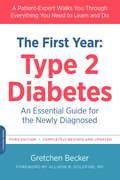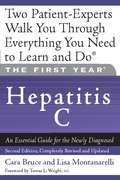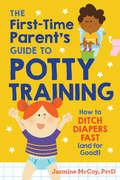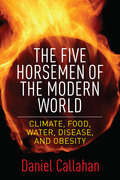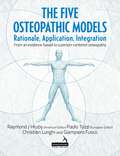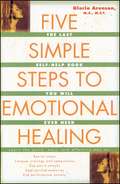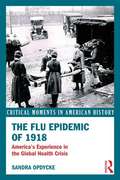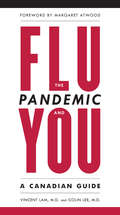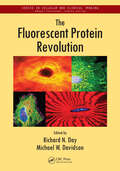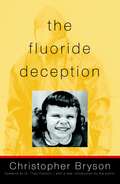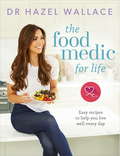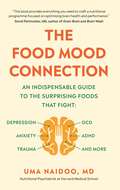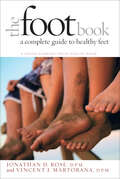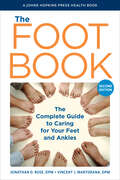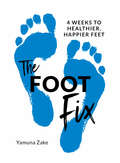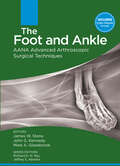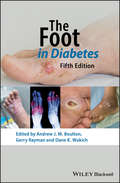- Table View
- List View
The First Year of Nursing
by Barbara FinkelsteinNurses from different walks of life and with different nursing specialties share the experiences they had when first entering the profession.
The First Year: An Essential Guide For The Newly Diagnosed (Marlowe Diabetes Library)
by Gretchen Becker Allison B. GoldfineDiabetes is one of the fastest growing diseases in the world; the American Diabetes Association reports that 1. 7 million new diagnoses are made each year. After her own diagnosis, Gretchen Becker became a "patient-expert," educating herself on every aspect of type 2 diabetes and eventually compiling everything she had learned into this step-by-step guidebook for others. Now in its third edition, The First Year: Type 2 Diabetes takes you through everything you need to know and do in your first year with diabetes. In clear and accessible language, Becker covers a wide range of practical, medical,and lifestyle issues, from coming to terms with your diagnosis to diet and exercise, testing routines, insurance issues, and the most up-to-date information on new medications and supplements.
The First Year® Hepatitis C: An Essential Guide for the Newly Diagnosed (The First Year)
by Cara Bruce Lisa MontanarelliThe fifth-year anniversary of the book ushers in a new phase of treatment and information, including protease inhibitors (which have been so successful in treating HIV), split-liver transplants, and prophylactic and therapeutic vaccines for HCV. Bruce and Montanarelli also offer updated information on medications that are toxic to the liver; Eastern and Western approaches to healing; nutrition guides; the types of hepatitis that have been identified and what is known; and living with coinfection (HCV and HIV, HBV, and HAV). Alarming statistics: Hepatitis C is the most common bloodborne virus: It has infected 300 million people worldwide (4. 1 million in the U. S. ) and kills 8,000 to 10,000 Americans each year. About 26,000 people in the U. S. are infected yearly. Chronic hepatitis C is the number one cause of liver transplants. Key lifestyle issues: The book offers emotional support for newly diagnosed patients, helps them navigate and overcome insurance obstacles, as well as providing suggestions for making necessary changes in diet, exercise, drinking habits, drug use, dating, and sex life. Bruce and Montanarelli also debunk common myths and offer ideas for coping with depression, fatigue, and the side effects of medications.
The First-Time Parent's Guide to Potty Training: How to Ditch Diapers Fast (and for Good!)
by Jazmine McCoyPotty train your child confidently, quickly, and successfully--even as a first-time parent!Are you nervous about potty training? Worried that you don't know enough to see it through to the end? Concerned that you don't have enough time to devote to it? This positive, practical, easy-to-follow guide is here to help.By approaching potty training with a proven program, first-time tips and tricks, the right tools, and a confident mindset, you can cross dirty diapers off your endless to-do list and celebrate your child's transition to the toilet. Here's everything you need to know to get your child out of diapers once and for all!The First-Time Parent's Guide to Potty Training features: • An easy, step-by-step, 3-day program for ditching diapers, including nap and nighttime training, day care strategies, and on-the-go potty training • Troubleshooting advice for accidents, backsliding, temper tantrums, and more • Guidance for your child if they're anxious, willful, or simply reluctantYou can potty train your child, and this book will guide you and cheer you on every step of the way.
The Five Horsemen of the Modern World: Climate, Food, Water, Disease, and Obesity
by Daniel CallahanIn recent decades, we have seen five perilous and interlocking trends dominate global discourse: irreversible climate change, extreme food and water shortages, rising chronic illnesses, and rampant obesity. Why can't we make any progress in counteracting these problems, despite vast expenditures of intellectual, institutional, and societal capital? What makes these global emergencies the "wicked problems" that resist our best efforts and only grow more daunting?Daniel Callahan, noted author and the nation's preeminent scholar in bioethics, takes a cross-cutting look at these global problems and shines a light on the institutions, practices, and actors that block major change. We see partisan political and ideological forces, old fashioned hucksters, and trumped up scientific disagreements, but also the problem of modern progress itself. Obesity, anthropocentric climate change, wasting illnesses, ecological degradation, and global famine are often the unintended consequences of unchecked industrial growth, reckless eating habits, and artificially extended lifespans. Only through well-crafted political, regulatory, industrial, and cultural counterstrategies can we change enough minds to check these threats. Big thinking on issues that are usually evaluated separately, this book is sure to scramble partisan divides and provoke unusual, heated debate.
The Five Horsemen of the Modern World: Climate, Food, Water, Disease, and Obesity
by Daniel CallahanIn recent decades, we have seen five perilous and interlocking trends dominate global discourse: irreversible climate change, extreme food and water shortages, rising chronic illnesses, and rampant obesity. Why can't we make any progress in counteracting these problems despite vast expenditures of intellectual, institutional, and social capital? What makes these global emergencies the "wicked problems" that resist our best efforts and only grow more daunting?Daniel Callahan, noted author and the nation's preeminent scholar in bioethics, examines these global problems and shines a light on the institutions, practices, and actors that block major change. We see partisan political and ideological forces, old-fashioned hucksters, and trumped-up scientific disagreements but also the problem of modern progress itself. Obesity, anthropogenic climate change, degenerative diseases, ecological degradation, and global famine are often the unintended consequences of unchecked industrial growth, insatiable eating habits, and technologically extended life spans. Only through well-crafted political, regulatory, industrial, and cultural counterstrategies can we change enough minds to check these threats. With big thinking on issues that are usually evaluated separately, this book is sure to scramble partisan divides and provoke unusual, heated debate.
The Five Osteopathic Models: Rationale, Application, Integration - from an Evidence-Based to a Person-Centered Osteopathy
by Giampiero Fusco Ray Hruby Christian Lunghi Paulo TozziFar from being simply a sequence of techniques, as practised in many countries osteopathy is an independent primary health care system based on principles applied through a manual practice: a unique profession that takes care of the whole person through the application of five models (biomechanical, neurological, respiratory-circulatory, metabolic, and behavioral). These conceptual models of the relationship between structure and function allow osteopaths to evaluate treatment with the aim of promoting health rather than curing disease.This book is intended as a manual for both students and osteopathic professionals interested in exploring the principles, objectives, origins and application of the five osteopathic models, from traditional concepts up to a modern vision, based on evidence and critical thinking. The selection criteria and rules for the application of each model, with their limitations and potential, are examined, to enable the reader to understand the rationale behind their use in a comprehensive, holistic and patient-centered practice.
The Five Simple Steps to Emotional Healing
by Gloria ArensonTap Your Troubles Away It's that simple. Meridian Therapy is a self-healing system that can be learned in minutes and can relieve a lifetime of emotional pain. A cutting-edge technique based on the ancient art of acupressure, it involves stimulating the energy meridians in the body by tapping on specific energy points and awakening their healing power. In Five Simple Steps to Emotional Healing, noted therapist Gloria Arenson explains the scientific basis of Meridian Therapy and teaches readers the five easy-to-follow steps that will allow them to break free from stress and negative emotions. Meridian Therapy can be practiced any time, anywhere, in order to Improve performance in sports, work, and the bedroom Stop the fears that limit activities and ruin relationships Eliminate the urge to procrastinate Conquer cravings and compulsions Heal emotional scars and painful memories Improve self-esteem Dissolve panic attacks before they start
The Fling That Changed Everything
by Alison RobertsTempted-to take another chance on love... Becoming a Wildfire Island paramedic is a dream come true for Lia Roselli-a chance for travel and adventure. What she doesn't expect is to fall in lust with her boss, Dr. Sam Taylor... Romantic entanglement is the last thing on Sam's mind; he's been badly burned by divorce. Yet there's no denying the passion that flares between them, and it's so much more than physical! As everything starts to change it's clear that Lia is tempting him to try love again!
The Flu Epidemic of 1918: America's Experience in the Global Health Crisis
by Sandra OpdyckeIn 1918, a devastating world-wide influenza epidemic hit the United States. Killing over 600,000 Americans and causing the national death rate to jump 30% in a single year, the outbreak obstructed the country's participation in World War I and imposed terrible challenges on communities across the United States. <p><p> This epidemic provides an ideal lens for understanding the history of infectious disease in the United States. The Flu Epidemic of 1918 examines the impact of the outbreak on health, medicine, government, and individual people's lives, and also explores the puzzle of Americans' decades-long silence about the experience once it was over. In a concise narrative bolstered by primary sources including newspaper articles, eye-witness accounts, and government reports, Sandra Opdycke provides undergraduates with an unforgettable introduction to the 1918 epidemic and its after-effects.
The Flu Pandemic and You: A Canadian Guide
by Vincent Lam Dr. Colin LeeAn essential survival guide – both to pandemic influenza, and to the hype surrounding it.Written by an emergency physician and a public health physician, The Flu Pandemic and You is a frank and clear book about how to prepare for the next influenza pandemic, and how to understand the broader context in which the threat exists. With cool heads and great professional expertise, the authors describe the history of influenza pandemics, the scientific reasons for the current health concern, the effects a pandemic would have, and the steps governments are likely to take when, not if, it hits. Drs. Lam and Lee carefully explain how readers can assess their level of risk, and set out practical advice on how an individual can prepare for a pandemic and maximize their chances of living through it. They draw on the latest evidence and their experience of the SARS outbreak of 2003. The Flu Pandemic and You develops a lucid framework to help people respond to the latest news stories about avian flu, and understand the current media anxiety about influenza in the context of the risks we all face in our daily lives. This crucially important book, full of reasoned, knowledgeable advice, is an indispensable handbook for fearful times.
The Fluorescent Protein Revolution
by Vijay K. Vaishnavi William KuechlerAdvances in fluorescent proteins, live-cell imaging, and superresolution instrumentation have ushered in a new era of investigations in cell biology, medicine, and physiology. From the identification of the green fluorescent protein in the jellyfish Aequorea victoria to the engineering of novel fluorescent proteins, The Fluorescent Protein Revoluti
The Fluoride Deception
by Theo Colborn Christopher BrysonWith the narrative punch of Jonathan Harr's A Civil Action and the commitment to environmental truth-telling of Erin Brockovich, The Fluoride Deception documents a powerful connection between big corporations, the U.S. military, and the historic reassurances of fluoride safety provided by the nation's public health establishment. The Fluoride Deception reads like a thriller, but one supported by two hundred pages of source notes, years of investigative reporting, scores of scientist interviews, and archival research in places such as the newly opened files of the Manhattan Project and the Atomic Energy Commission. The book is nothing less than an exhumation of one of the great secret narratives of the industrial era: how a grim workplace poison and the most damaging environmental pollutant of the cold war was added to our drinking water and toothpaste.
The Flyer
by Marjorie JonesPaul Campbell has fought the Turks, the Germans, and the occasional rogue crocodile, and as a confirmed bachelor, veteran of the Great War, and jack-of-all-trades in the rough country of Western Australia, he is free to live the rest of his life in peace. He has only one goal: to make life easier on the residents of the Outback by flying medicine, supplies, and the rare letter to those who live in Australia’s sprawling interior. That is, until a new doctor lands on his doorstep begging for a gentle hand and a warm kiss#151;even if she doesn't know it yet. Helen Stanwood left the relative comfort of her San Francisco home with a mission: to forget the pain of her former existence by devoting herself to helping those in need. But when she arrives in Australia she is faced with the realization that she can't run away from herself, her past, or Paul.
The Foaling Primer: A Step-by-Step Guide to Raising a Healthy Foal
by Cynthia McFarlandStart your foal off on the right hoof! With correct handling, health care, and training during the first year, you can establish a strong foundation that will benefit your horse throughout his life. From bottle feeding to rope leading, Cynthia McFarland covers everything you need to know as you guide your foal from birth to yearling. With an emphasis on recognizing critical developmental signs, McFarland’s expert advice will help you raise a healthy, happy, and well-adjusted foal.
The Food Medic for Life: Easy recipes to help you live well every day
by Dr Hazel WallaceAs someone who juggles many jobs between being a doctor, a personal trainer and an author, I understand how difficult it can be to prioritise food and eating well.I wanted to create a collection of beautiful recipes that are not only nutritious and great tasting, but super quick and simple to make, using only a handful of ingredients. The Fuel Up section is designed for just that - it is where you will find my recipes for grab-and-go breakfasts, lunches on the run and dinners that take less than 30 minutes to satisfy you after a long day at work! However, I truly believe that when we do have the time to cook a meal, bake some bread and sit down with friends and family to share some food, we should totally embrace those moments. This is where the Power Down section comes in: for when you're not in a hurry, I have included my chosen recipes for lazy weekend brunches, family dinners, breads and teatime treats. This is a cookbook that will help you fall in love with cooking and improve your relationship with food, so that you approach it not only as a source of nutrients, but also happiness, satisfaction and health.Hazel xIncludes more than 100 recipes PLUS:- 10 'no recipe recipes' for emergency snacks + meal prep hacks for maintaining a healthy lifestyle when you're busy- an introduction to Hazel's five store-cupboard saviours, including 10 ways to cook with each one- a key for special dietary requirements including vegetarian, vegan, gluten-free and low sugar- nutritional advice covering the basics of nutrition, how to meet your 5-a-day and special nutritional requirements for a plant-based diet- features on how to live well for optimum health, with information on sleep, meditation, mindfulness and mindful eating
The Food Medic for Life: Easy recipes to help you live well every day
by Hazel WallaceAs someone who juggles many jobs between being a doctor, a personal trainer and an author, I understand how difficult it can be to prioritise food and eating well.I wanted to create a collection of beautiful recipes that are not only nutritious and great tasting, but super quick and simple to make, using only a handful of ingredients. The Fuel Up section is designed for just that - it is where you will find my recipes for grab-and-go breakfasts, lunches on the run and dinners that take less than 30 minutes to satisfy you after a long day at work! However, I truly believe that when we do have the time to cook a meal, bake some bread and sit down with friends and family to share some food, we should totally embrace those moments. This is where the Power Down section comes in: for when you're not in a hurry, I have included my chosen recipes for lazy weekend brunches, family dinners, breads and teatime treats. This is a cookbook that will help you fall in love with cooking and improve your relationship with food, so that you approach it not only as a source of nutrients, but also happiness, satisfaction and health.Hazel xIncludes more than 100 recipes PLUS:- 10 'no recipe recipes' for emergency snacks + meal prep hacks for maintaining a healthy lifestyle when you're busy- an introduction to Hazel's five store-cupboard saviours, including 10 ways to cook with each one- a key for special dietary requirements including vegetarian, vegan, gluten-free and low sugar- nutritional advice covering the basics of nutrition, how to meet your 5-a-day and special nutritional requirements for a plant-based diet- features on how to live well for optimum health, with information on sleep, meditation, mindfulness and mindful eating
The Food Mood Connection
by Dr Uma NaidooDid you know that blueberries can help you cope with the after-effects of trauma? That salami can cause depression, or that boosting Vitamin D intake can help treat anxiety?When it comes to diet, most people's concerns involve weight loss, fitness, cardiac health, and longevity. But what we eat affects more than our bodies; it also affects our brains. And recent studies have shown that diet can have a profound impact on mental health conditions ranging from ADHD to depression, anxiety, sleep disorders, OCD, dementia and beyond.Dr. Uma Naidoo is a board-certified psychiatrist, nutrition specialist, and professionally trained chef. In The Food-Mood Connection, she draws on cutting-edge research to explain the many ways in which food contributes to our mental health, and shows how a sound diet can help treat and prevent a wide range of psychological and cognitive health issues.Packed with fascinating science, actionable nutritional recommendations, and delicious, brain-healthy recipes, The Food-Mood Connection is the go-to guide to optimizing your mental health with food.
The Food You Crave: Luscious Recipes for a Healthy Life
by Ellie KriegerDo you think that healthy food couldn't possibly taste good? Does the idea of "eating healthy" conjure up images of roughage and steamed vegetables? Author Ellie Krieger, host of Food Network's Healthy Appetite, will change all that. A registered dietitian, Ellie is also a lover and proponent of good, fresh food, simply but deliciously prepared. And she's not about denial--no nonfat foods here, because when you take the fat out of natural foods, in go the chemicals. Don't deny yourself butter--use a pat of it, but put it front and center on those mashed potatoes, so you can revel in it with all your senses.The Food You Craveis all you'll need to change the way you eat and change the way you feel. It contains 200 recipes that cover every meal of the day and every craving you might have. Every recipe contains a complete nutritional breakdown, as well as tips on ingredients and techniques that will keep you eating smart and eating well.
The Foot Book: A Complete Guide to Healthy Feet (A Johns Hopkins Press Health Book)
by Jonathan D. Rose Vincent J. MartoranaAching or painful feet make it hard to stand or walk—not to mention dance, play sports, and take part in other activities. To keep you on your feet, this book offers a rich resource for understanding what can go wrong and how disorders, diseases, and injuries to the foot are diagnosed and treated.In this readable guide to common conditions that affect the foot and ankle, podiatrists Jonathan D. Rose and Vincent J. Martorana outline the professional and self-care treatment options available. What works for one person’s foot pain does not necessarily work for someone else’s, so Doctors Rose and Martorana discuss proper foot care practices in a way that helps readers make good decisions about which treatment option will work best for them. Often called a marvel of biomedical engineering, the human foot is a complex and astonishingly versatile part of our anatomy. This book addresses the entire foot, inside and out, describing in plain English its special design characteristics and biomechanical operations. Everything is covered—from corns and calluses to cancer and skin and nail problems, including special sections on children’s feet, sports injuries, footwear, and orthotics. The Foot Book is an all-inclusive resource for everyone suffering from foot and ankle disorders, as well as physicians and other medical personnel who care for them.
The Foot Book: The Complete Guide To Caring For Your Feet And Ankles (A\johns Hopkins Press Health Book Ser.)
by Jonathan D. Rose, DPM and Vincent J. Martorana, DPMThe Foot Fix: 4 Weeks to Healthier, Happier Feet
by Yamuna ZakeThis book will empower you to get your feet functioning as they should do, without any medical intervention. Includes a 4-week plan of quick-and-easy exercises to get your feet back into shape, plus solutions for specific foot issues, from plantar fasciitis to fallen arches.This is a uniquely helpful and accessible guide to taking control of your own foot health by holistic heath innovator Yamuna Zake. We don't need doctors, orthotics or even surgery to relieve common foot problems, such as plantar fasciitis, bunions, neuromas, arthritis, hammertoes, and flat feet. By learning a correct gait that uses the entire foot to distribute weight, we can relieve and prevent common foot problems without any medical intervention. The book offers an easy-to-follow 4-week program of routines that take just 15 minutes a day during the program and allows readers to fix their feet and take ownership of their body. Each of the four weeks focuses on a different part of the foot: the heel, the arch, the ball and the toes. There are 3-4 exercises in each section and readers try them all and can choose to focus on those exercises in each section that they enjoy most. This programme is then supported with mindful foot practices to ensure bad habits don't return. Six common foot problems are also explored, including their causes (specific incorrect walking patterns) and ways of preventing and relieving them (exercises plus mindful practices). You won't find any medical concepts or terminology in this book, nor do you need to learn complicated foot anatomy. The whole program is based on what you already know: walking. You'll learn how to walk and stand correctly and to use every part of your feet as nature intended. That's all you need to do!
The Foot and Ankle: AANA Advanced Arthroscopic Surgical Techniques (AANA Advanced Arthroscopic Techniques series)
by James Stone Mark Glazebrook Kennedy JohnCo-published with the Arthroscopy Association of North America, The Foot and Ankle: AANA Advanced Arthroscopic Surgical Techniques is a comprehensive technique-based book that presents the latest diagnostic and reconstructive techniques in arthroscopic surgery for the foot and ankle. The Foot and Ankle: AANA Advanced Arthroscopic Surgical Techniques is authored by premier arthroscopic surgeons Drs. James W. Stone, John G. Kennedy, and Mark Glazebook, and their international list of expert contributors. This comprehensive resource includes preferred physical examination testing and diagnostic imaging choices in pre-operative planning and patient selection, state-of-the-art step-by-step description of the procedures, detailed surgical equipment lists to perform each procedure, clear and precise indications for surgery and the thoughtful rationale behind stated contraindications, controversial indications, post-operative protocols, and potential complications. The written text is supported by numerous color images and a website with invaluable, narrated video clips depicting disease-specific arthroscopic techniques specific to the foot and ankle. Features inside The Foot and Ankle: AANA Advanced Arthroscopic Surgical Techniques Narrated video accompanies all surgical techniques, focusing on the stepwise approach to each operation Consistent organization throughout the book results in a bulleted and user-friendly interface for a quick reference or prolonged study Top 5 Technical Pearls for each procedure to enhance outcomes and to avoid common pitfalls and complications High-quality artwork and figures to compliment clinical images Equipment and surgical technique checklists for quick reference prior to surgery Each expert contributor was chosen for his or her expertise for a specific topic related to The Foot and Ankle, so the reader benefits by the highest quality and treatment recommendations to provide state-of-the-art care to his or her patient.Some chapter topics include:-Reconstruction Using Allograft and Autograft-Lateral Approach to Subtalar Arthroscopy-Achilles Tendinopathy-Chondral Defects of the First MTP Joint-Matrix-Induced Autologous Chondrocyte Implantation
The Foot in Diabetes (Practical Diabetes)
by Gerry Rayman Andrew J. M. Boulton Dane K. WukichFully revised and updated edition of this popular book, addressing all issues concerning the diabetic foot, one of the most prevalent problems in diabetes, with a strong emphasis on practical aspects of delivering care.
The Forensic Casebook: The Science of Crime Scene Investigation
by N. E. GengeTHE ULTIMATE READERS' GUIDE TO THE ART OF FORENSICS! An intrepid investigator crawls through miles of air conditioning ducts to capture the implicating fibers of a suspect's wool jacket . . . A forensic entomologist discovers insects in the grill of a car and nails down a drug dealer's precise geographical path . . . A gluttonous criminal's fingerprints are lifted from a chocolate truffle. . . . Filled with these and many other intriguing true stories, and packed with black and white illustrations and photographs, The Forensic Casebook draws on interviews with police personnel and forensic scientists--including animal examiners, botanists, zoologists, firearms specialists, and autoposists--to uncover the vast and detailed underworkings of criminal investigation. Encyclopedic in scope, this riveting, authoritative book leaves no aspect of forensic science untouched, covering such fascinating topics as:* Securing a crime scene* Identifying blood splatter patterns* Collecting fingerprints--and feet, lip, and ear prints* Interpreting the stages of a body's decay* Examining hair and fiber evidence* Trace evidence from firearms and explosives* "Lifting" DNA prints* Computer crime and forensic photography* Career paths in criminal scienceLucidly written and spiked with real crime stories, The Forensic Casebook exposes the nitty gritty that other books only touch upon. Here is a reference book as addictive as a page-turning novel of suspense.From the Trade Paperback edition.

